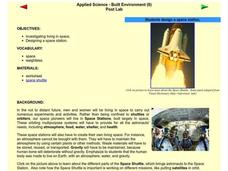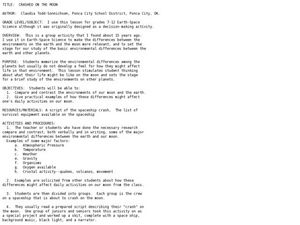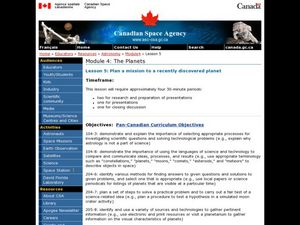Curated OER
Design a Space Station
Sixth graders investigate living in space. In this science lesson, 6th graders discuss what it is like to live in space and create their own space station or space city of the future.
Curated OER
Living In Space
In this reading comprehension worksheet, students read a short text about living in space. Students then answer 6 multiple choice questions about the story.
Curated OER
Crashed on the Moon
Students compare and contrast the environments of the moon and the earth. They discover how the differences might change one's daily activities.
Curated OER
Robot Earth
Students construct a simple robotic energy transformer. In this space science lesson, students explain how energy is transformed from one form to another. They identify the different uses of robotic devices.
Curated OER
Mercury, Venus, and Earth
Students learn information about the planets Mercury, Venus, and Earth by playing a trivia game.
Curated OER
Space Exploration- Voyagers 1 and 2
Everyone loves to learn about outer space. This space exploration passage has 10 questions relating to Voyager 1 and 2. There are both comprehension and vocabulary questions. The activity could be used with upper elementary or ESL students.
Curated OER
Life on the Moon
Students study the physical properties of the Moon. In this life on the moon lesson students describe the ways life on the Moon would be different than on Earth.
Teach Engineering
Get Me Off This Planet
What do Newton's Laws have to do with getting from Earth to Mars?The activities in this resource show how Newton's Laws work with rockets to get them into space. Background information includes facts about orbits and how orbits...
Curated OER
How Can a Spacecraft Always Face the Sun?
Students determine the correct orbital path for a satellite that collects data about the sun so that its view of the sun never be obstructed by the Earth.
Curated OER
The Space Shuttle
Students share what they comprehend about the space shuttle program. They are given information about the first space shuttle mission. Students work in groups to investigate the different shuttle missions from April 1981 through January...
NASA
Space-Based Astronomy on the Internet
Young scientists compile everything they have learned into a report in the fifth and final lesson in a unit on the visible light spectrum. Access to photos from observatories, telescopes, and satellites allows learners to compare...
Curated OER
Lifting Bodies: Designing Your Own Spacecraft
Students work cooperatively with classmates to design a wingless vehicle that can fly back to Earth from space, landing like an aircraft. Students plan and describe their models. Also, they will research facts about the lifting body...
Curated OER
Space Food
What do astronauts eat in outer space? Kids can read an informational passage to learn about space food. The passage includes prompts that have learners identify the main idea and key details, then write a paragraph summarizing the text....
International Technology Education Association
Dampen That Drift!
The spacecraft is drifting too far off course! Two games help explain how a spacecraft can use its thrusters to maintain its position. The games have pupils be the components of vectors in order to create and counteract the...
NASA
Space Images
As technology advances, so does our understanding of the universe around us. Thanks to the Hubble Telescope, Mars rovers, and other high-resolution cameras, there are amazing photographs of celestial bodies, planets, comets, and more...
DiscoverE
Touch Down
Protect the marshmallows! Groups create contraptions that will keep marshmallows in a cup, even after dropping them from a certain height. This is a fun way to model the shock-absorbing capabilities of spacecraft.
Curated OER
Data Handling Techniques
Students study data analysis methods. In this data analysis lesson, students study data compression and data editing methods used for the spacecraft Galileo. Students study the 'lossless' and 'lossy' techniques.
Curated OER
Crashed On the Moon
Students compare/contrast the environments of our moon and earth, and examine examples of how these differences would affect their daily activities on our moon. They develop lists of emergency supplies to bring if their spaceship crashed...
Curated OER
Plan a Mission to Recently Discovered Planet
Pupils plan a mission to a recently discovered planet. In this science lesson, students research spacecraft design, distances in space, long-term missions in space, and life-sustaining planets. Pupils work in groups to research an...
Curated OER
Hello, Is Anybody Out There? (cont.)
In this space science worksheet, students read an informative passage about radio waves and the possibility of sending messages in space. The passage describes a "Sounds of Earth" record on the Voyager satellite which contains messages...
EngageNY
How Far Away Is the Moon?
Does the space shuttle have an odometer? Maybe, but all that is needed to determine the distance to the moon is a little geometry! The lesson asks scholars to sketch the relationship of the Earth and moon using shadows of an eclipse....
NASA
Cleaning Water
From their sweat to the water vapor in their breath, astronauts recycle every possible drop of water while in space. After watching a short video describing the different ways materials are recycled and reused in space...
Curated OER
Coronal Mass Ejections
For this coronal mass ejections worksheet, students observe a time line of events that took place during a solar storm. Students use the time line to answer 3 questions about the solar storm and the time it took to reach Earth. Students...
Curated OER
Apollo Moon Landing
Students explore paper rockets, learn about the Apollo Program and Apollo spin-offs, and use simple office supplies to design and create a new useful product. This amazing plan is incredibly well written and leads students through a...























